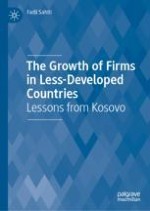2019 | OriginalPaper | Chapter
3. Firm Growth Factors: A State of the Art Review and Research Issues
Author : Fadil Sahiti
Published in: The Growth of Firms in Less-Developed Countries
Publisher: Springer International Publishing
Activate our intelligent search to find suitable subject content or patents.
Select sections of text to find matching patents with Artificial Intelligence. powered by
Select sections of text to find additional relevant content using AI-assisted search. powered by
